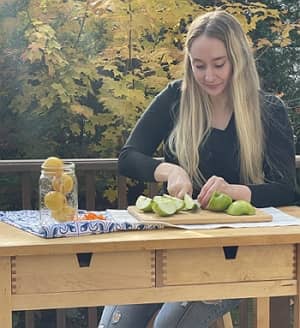Learn how to nourish your body through each phase of your menstrual cycle with the right foods to support hormone balance, energy, and overall well-being. Discover how phase-specific nutrition can help reduce PMS symptoms, boost fertility, and optimize your health.
The menstrual cycle is often referred to as the “fifth vital sign” for good reason—it offers valuable insights into your body’s overall health, much like temperature, pulse, and heart rate do. Prioritizing fertility health, supporting hormone balance, managing symptoms, and nourishing your body for sustained energy can positively impact all body systems.
This is why phase-specific nutrition is essential. By tailoring your diet to each stage of your cycle, you can optimize your overall health and well-being while promoting a smoother, more balanced cycle.
Let’s dive into each phase of the menstrual cycle—what’s happening in the body and how to best support it through nutrition.

- The cycle starts with the menstrual Phase (Days 1-5). This is typically when most women experience bleeding due to the shedding of the uterine lining if pregnancy has not occurred. During this time, estrogen and progesterone levels are at their lowest, which can lead to feelings of fatigue and cravings for comfort foods.
During this phase, the aim is to support blood loss and manage symptoms. Include:
- Replenish iron levels: Include iron-rich foods such as spinach, red meat, organ meats, and lentils to compensate for blood loss.Pair plant-based iron sources with vitamin C-rich foods (e.g., citrus fruits, peppers) to enhance iron absorption.
- Stay hydrated: Combat bloating and fatigue by drinking plenty of water and incorporating hydrating foods like cucumbers and watermelon.
- Navigate food cravings: Practice self-compassion with cravings. Seek nourishing alternatives when possible, but remember it’s okay to indulge. For savory or salty cravings, consider roasting a tray of hearty vegetables like potatoes, drizzled with olive oil and your favorite seasonings, as a satisfying and nutritious option.
2. Menstruation takes place during the follicular phase, which concludes with your fertile window and ovulation. Following menstruation, estrogen levels gradually rise, stimulating follicle growth and preparing your body for ovulation.
Ensure that your meals include healthy fats, fiber, proteins, and probiotic-rich foods to support hormone production, overall nutrition, and gut health. Here’s how to structure your meals for optimal nourishment:
- Include fats at all your meals. Fats are essential for hormone production and cell structure. Incorporate foods such as grass-fed butter, coconut oil, olives, avocado, nuts, seeds, and olive oil.
- Focus on Fiber-Rich Foods. Build your meals and snacks around fiber to support digestion and hormone regulation. Choose fruits, vegetables, starchy vegetables, whole grains, and legumes. Prioritize nutrient-dense options like leafy greens, which are rich in folate and antioxidants. Or sweet potatoes that are also high in beta-carotene, the plant form of vitamin A.
- Lastly, don’t forget your proteins! Protein is nutrient-dense and promotes satiety, keeping you full and energized. Opt for sources such as grass-fed beef, organ meats, pasture-raised poultry, organic dairy, and pasture-raised eggs.
- Incorporate Probiotic-Rich Foods Daily. Probiotics support gut health by nourishing beneficial bacteria and promoting a healthy gut microbiome. Include fermented foods like yogurt, kimchi, and kefir in your daily diet.
3. Our cycle then peaks in ovulation (typically around days 10-23). During this phase, estrogen and luteinizing hormone (LH) reach their highest levels, marking your fertile window. This is an important time to prioritize nourishment to support your body during this critical phase.
What to focus on during this phase:
- Incorporate Anti-Inflammatory Foods. Inflammation can disrupt hormone balance and interfere with the ovulatory process. Include foods like salmon, walnuts, and anti-inflammatory spices such as turmeric to support your body during this phase.
- Prioritize Zinc-Rich Foods. Zinc plays a crucial role in cell division and hormone production, both essential for ovulation. Add foods like seafood, pumpkin seeds, and chickpeas to your meals to boost your zinc intake.
- Stay Hydrated and Eat High-Fiber Foods. Fiber supports digestion and helps your body eliminate excess hormones, which is especially important during this phase of intense activity. Focus on daily fiber-rich foods such as fruits, vegetables, starchy vegetables, whole grains, and legumes.
4. Our cycle ends with the postovulatory phase, or better known as the luteal phase (lasts about 12-24 days). Recently gaining attention on social media, this phase—once commonly referred to as “PMS”—is now being recognized by its scientific name.
During the luteal phase, progesterone levels rise to prepare the body for a potential pregnancy. If pregnancy doesn’t occur, hormone levels drop, leading to the symptoms typically associated with PMS.
This phase is primarily about managing symptoms and supporting your body during this hormonal shift.
- Control Sweet Cravings: Opt for savory options or satisfy your sweet tooth with complex carbohydrates such as sweet potatoes and brown rice. Maintain stable energy levels by eating regular, balanced meals and staying hydrated.
- Reduce Water Retention and Bloating. Drink plenty of water and include magnesium-rich foods like dark chocolate, spinach, and almonds. Manage inflammation by incorporating omega-3-rich foods such as salmon and flaxseeds into your diet.
- Support Mood. Boost your intake of magnesium and vitamin B6-rich foods like bananas, chicken, and sunflower seeds to promote emotional balance.
- Avoid Processed Foods: Across all phases of your cycle, steer clear of processed and ultra-processed foods, which can disrupt your body’s natural functions and fail to provide the nourishment needed to manage your cycle effectively.
Eating in sync with your menstrual cycle is a powerful way to support your body’s natural rhythms. By tailoring your diet to the hormonal shifts of each phase, you can enhance your energy, reduce PMS symptoms, and promote overall hormone balance. Start small by incorporating one or two foods for each phase and listen to how your body responds. Your cycle is unique, and so is your journey to hormone harmony.
To learn more about what Dining With Nature offers for fertility nutrition care – hit the Explore The DWN Programs button below or take a look at our Services page.

